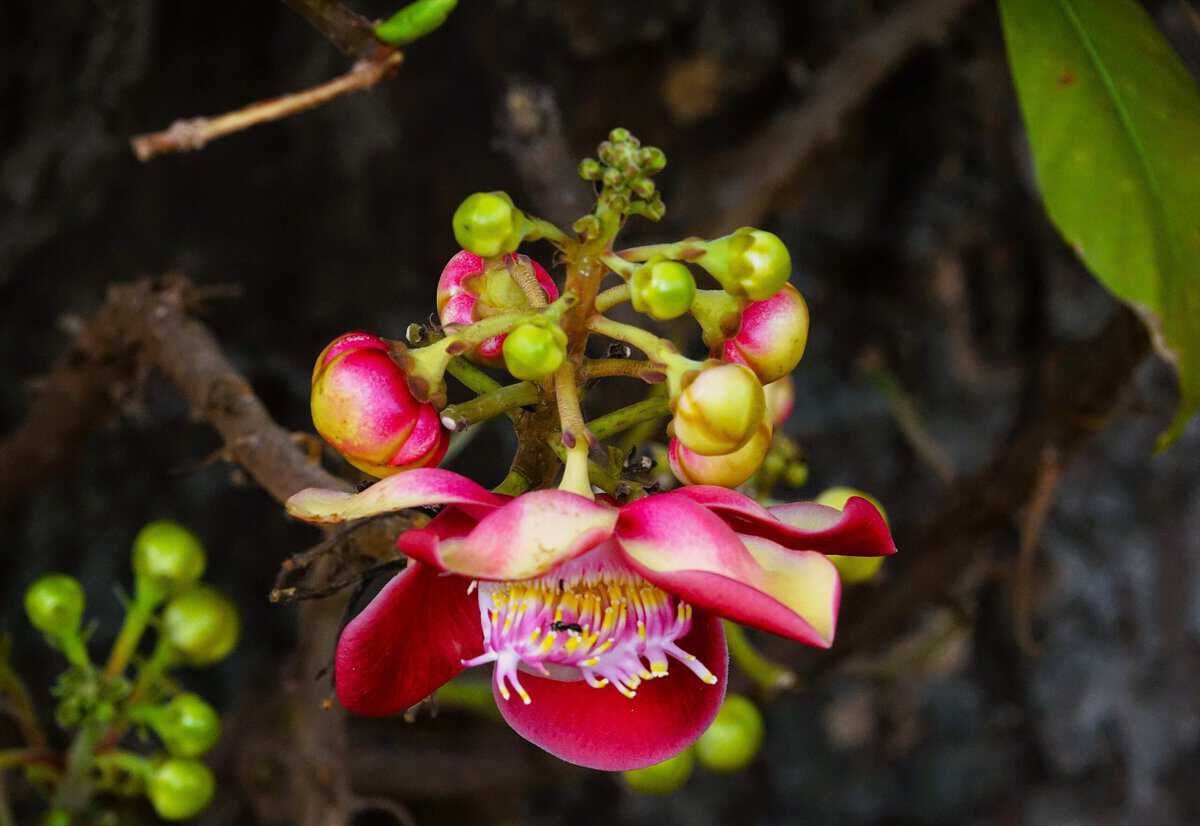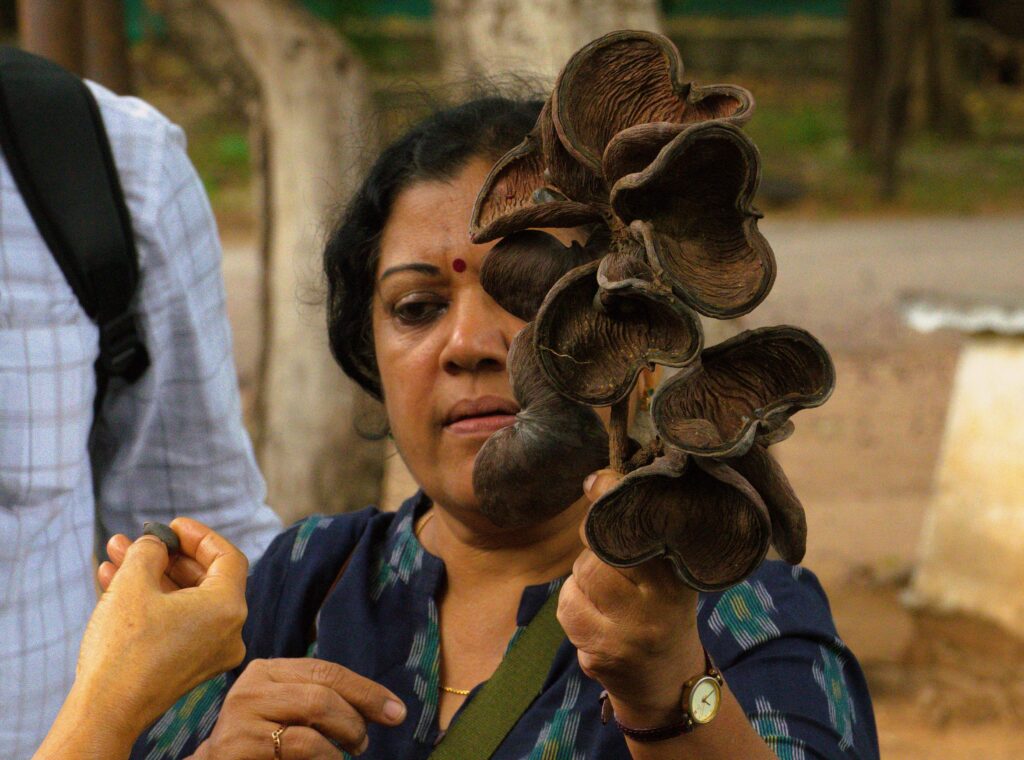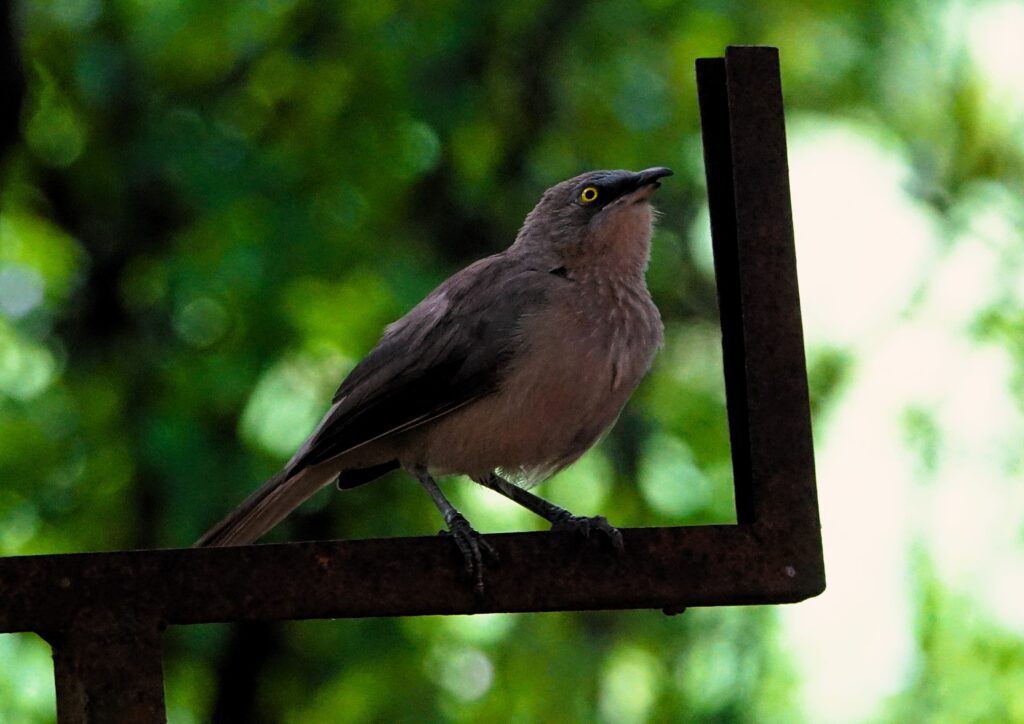
The sun was up, spilling its sheen through the monsoon clouds and beginning to rise over the bustling city of Hyderabad. Not wanting to miss the Nature Walk event, I hastily drove 17 km from my residence, navigating the morning traffic to arrive at Koti in Hyderabad by 7:30 am. I reached 10 minutes late, just as the first light of day filtered through the canopies of ancient trees.
Meanwhile, a motley group of 70 young and old citizens had gathered for the Nature Walk on the 3rd of August. The chosen monthly walk venue was the 200-year-old historic Koti Women’s College campus, a former British Residency, sprinkled with abundant old trees amidst 50 heritage edifices. The team leaders, Sadhana Ramachander and Kobita Dass, two passionate ecologists, were already briefing the eager participants on the nuances of the Nature Walk. After a swift headcount, the group was guided into the sprawling campus of 42 acres teeming with flora and fauna.
As the Nature Walk began, the first stop was a botanical bonanza in the form of the Cannon Ball Tree, a fascinating species standing about 15-feet tall with a straight trunk and a rounded crown. The tree had many showy red-yellowish-white flowers growing in clusters, emitting a strong, sweet fragrance.
Similarly, the fruits sprouted in clusters, spherical and woody, resembling cannonballs, hence the name.
Sadhana explained that the Cannon Ball is a distinctive fruit, which falls from the tree and explodes on impact, scattering seeds. Nearby was the lonesome Sandalwood tree, looking small and pale beside the Cannon Ball tree, but upon close observation, it had bunches of miniature green and maroon flowers attracting tiny flies and insects.

Further ahead, the nature ramblers were shown a massive old Banyan tree with dangling roots ready to anchor to the ground and support the mother tree. Adjacent to it was a Bougainvillea with its colourful paper flowers. Over the years, it had grown into a massive tree with a thick trunk, probably planted during the British and Nizam era. A few yards away stood a fruit-laden Jamun tree with both raw and ripe fruits, many of which had fallen to the ground and were eagerly collected by some of the walkers. Kobita explained that to spot and identify a tree, first look down for telltale indicators like fallen flowers, fruits, and leaves, and then look up to identify the tree. After another 20 yards, we came across a tree called Junglee Badham (Sterculia foetida) and found some fallen fruits, as well as plenty of green fruits still clinging to the tree in bunches split into 5-7 segments. Interestingly, the Junglee Badham is also known as the “Skunk Tree” or “Java Olive” due to its distinctive and pungent odour. We were also shown a strange plant growing on a Neem tree called Mistletoe, a clever parasite that does not grow on the ground. Instead this healthy plant was attached to a thick branch of the Neem tree, with specialized roots that are able to cling-on and penetrate the host plant to derive water and nutrients.
Meanwhile, a big group of Large Gray Babblers made a ruckus with their loud calls as they scrambled up and down the trees searching for their morning feed of insects and ground grubs. At this juncture, the group marvelled at the diversity of tree and plant life. Tall, stately trees stood alongside shrubs, bushes, and climbers with tendrils and patches of grass growing luxuriantly, spurred by the first flush of rains. Kobita pointed out the medicinal properties of many trees and their leaves, emphasizing their importance in traditional healing practices. Meanwhile, we spotted a black butterfly fluttering about in search of a sunny spot, squirrels scampered, and a peacock was sighted at a distance.

After taking a short tour of a manicured garden next to a British graveyard, the group then moved towards a grand old specimen strangely called the Guest Tree, a landmark that had stood on the campus for centuries. Its massive trunk and multiple branches created a natural pavilion, offering shade and a sense of awe. The Guest Tree (Kleinhovia hospita) is evergreen with thick foliage, growing over 50 feet high, with a dense rounded canopy. It will soon have its seasonal flowering, a sight worth waiting, we were told. Beneath its sprawling branches, stories were shared about the tree’s significance and historical perspective. The students listened intently, imagining the generations of young and old who had found solace and inspiration under its protective canopy.
Sadhana explained that the very first Nature-Walk took place in 2015 on the IIIT Campus, where a talk about trees was followed by a Nature-Walk around the campus. Later, a request from the College of Defence Management, Sainikpuri, led the duo to conduct another talk and walk. In 2016, informal tree walks around Hyderabad Public School as part of the Hyderabad Literary Festival (HLF) further formalized the Nature-Walk as part of HLF 2017 and 2018. Some participants requested regular nature walks, and that’s how it all started in April 2017 when the first publicly announced Nature-Walk was conducted at KBR National Park. Some positive press coverage added momentum to the initiative, and now every month people eagerly participate in these Nature-Walks.
For the last seven years, Sadhana Ramachander and Kobita Dass have covered several green spaces in Hyderabad, including Indira Park, the University of Hyderabad campus, Qutub Shahi Tombs, Godrej Green Business Centre, Public Gardens, Lotus Pond at Banjara Hills, Secunderabad Club, Ficus Garden at Durgam Cheruvu, Kapra Lake, and many more.

The recent ramble at Women’s College in Koti, a constituent college of Osmania University, marked their 60th Nature-Walk, exploring various green groves and woodlands of Hyderabad. The Women’s College, a venerable institution nestled in the heart of the city, is more than just a place of academic pursuit. It is a sanctuary where nature weaves a tapestry of vibrant life, inviting all who wander its paths to discover its secrets, some hidden in plain view. Nature lovers who came from across the city congregated for a leisurely stroll through the campus, marvelling at its wealth of tall trees, small shrubs, blooming plants, and even some dead tree trunks. We were told that these tree-walk-talks help citizens appreciate the real value of trees, along with their aesthetic, curative, and commercial components.

After nearly three hours of joyfully exploring the trees, trunks, leaves, canopy, fruits, flowers, and even birds and butterflies lurking within the Koti Women’s College campus, the stroll through Nature’s classroom came to an end. With loads of memories, photos, and video clips, it was a time well spent, and participants were eager for the next Nature-Walk to be conducted by Sadhana and Kobita in another part of the city. If you are interested in these Nature-Walks, get in touch via their Instagram handle to join in appreciating the foliage, flowers, and fruits on the Nature-Walks: https://www.instagram.com/nature_lovers_of_hyderabad/.
